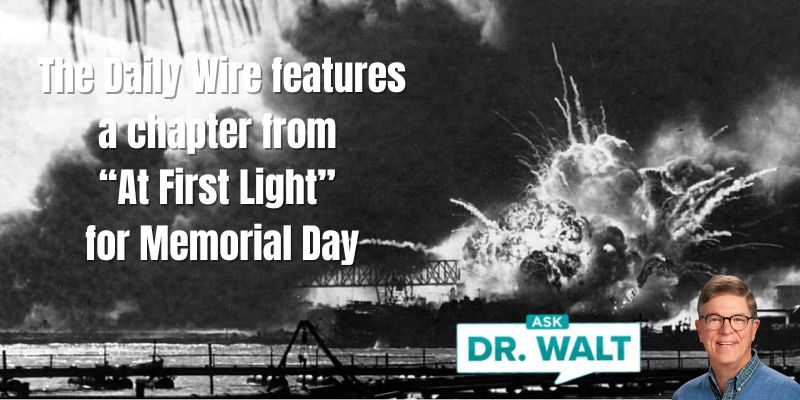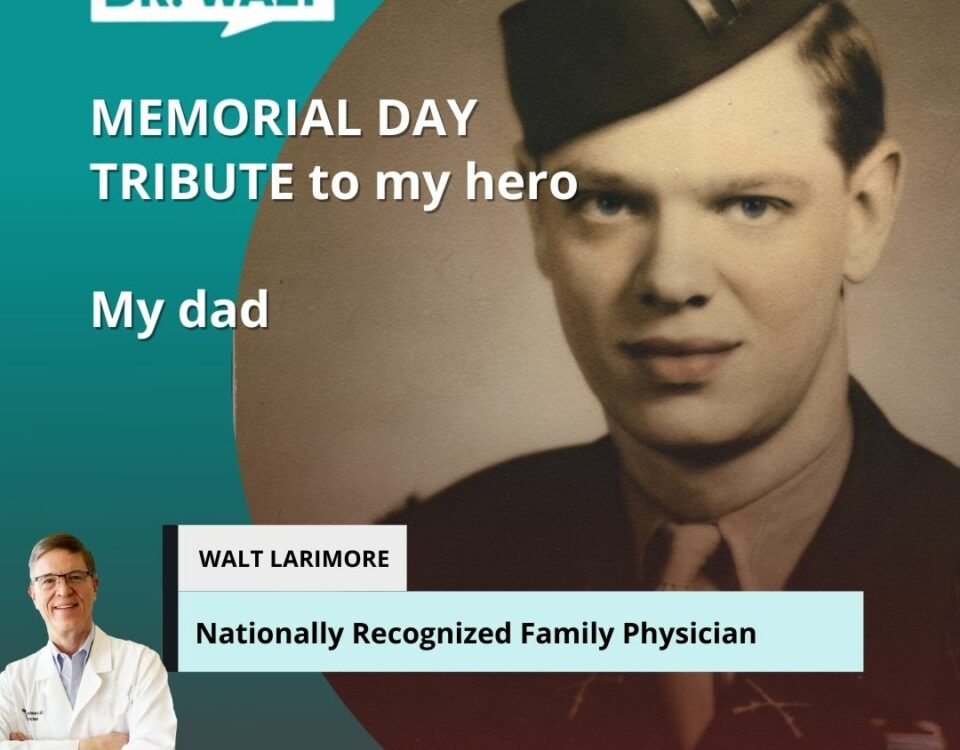
Ask Dr. Walt 35 – Sexual identity and transgenderism
January 22, 2024
A newly discovered eyewitness account of my father’s last WWII battle in which he lost his leg and almost his life
January 24, 2024While Phil was waiting to ship out at Fort Meade, Maryland, his future unit, the Army’s 3rd Infantry Division, was beginning its 4th amphibious D-Day, after its previous D-Days in French Morocco, Sicily, and Salerno, Italy.

ANZIO AND THE RACE TO ROME BEGINS
With the new year, a switch in plans sent the 3rd to the Naples staging area to prepare for a landing 30 miles south of Rome, an operation that was to roll back the enemy on the southern Italian front. The 3rd and a brigade of the British 1st Div. landed Jan. 22 near the little resort towns of Nettuno and Anzio. Winston Churchill once spoke of “tears, sweat and toil.” Anzio was paid for in guts – American and British guts. More than 6000 men died during the next few months to protect 100 square miles of beachhead. In that hallowed niche reserved for names like Bataan and Guadalcanal, Anzio will live forever.
Anzio always will be a vivid memory to the men who fought there … and survived.
Three regiments landed abreast, each speared by an assault battalion. By mid-afternoon next day, they were 10 miles inland. The enemy’s reaction was swift. Instead of withdrawing, he raced fresh troops from the Rome vicinity and northern Italy and hurled them into battle. When a 45th Inf. Div. combat team landed on the beachhead D plus 6, an equivalent of three divisions loomed in front of Cisterna on Highway 7 as the 3rd regrouped for its first assault.
The brick-wall defense stopped the attack which began Jan 29 and ended early Jan. 31. When the 7th’s 1st Bn. finally was relieved, less than 200 men were left; 2nd Bn. had 400; 3rd Bn., 600. Closest to Cisterna were 1st Bn., 30th, and 2nd Bn., 15th, which had to swing to the defense only 1500 yards from the objective.
Anzio was barely 14 miles wide and 10 miles from sea to front at its deepest penetration. The enemy squatted around the beachhead’s perimeter and in the Colli Laziali Hills with perfect observation of every square inch of beachhead.
Sally, the Berlin broadcaster, knew what type of rations men ate. Among songs she dedicated was, “Don’t Get Around Much Anymore.” Among her remarks was, “As long as there is blue and white paint, there’ll always be a 3rd Division,” The blue and white paint outlasted Sally.
When VI Corps ordered defensive emplacements dug along the Mussolini Canal — the beachhead line – weary, battered Marne-men doggedly refused to let the Krauts push them back. The Mussolini Canal plan was discarded. That line, won during the first Cisterna assault, was to be held. Men like T/5 Eric Gibson and Pfc Lloyd Hawks would have approved the decision, the former if he hadn’t been killed when he left his field kitchen to lead a squad of recruits into their first battle; the latter, if he hadn’t been near death in a Naples hospital after saving the lives of two buddies although he had been wounded in the head, suffered a shattered arm and leg. Both men won the Medal of Honor.
~~~~~
“The ultimate test, and the battle for which the 3rd Division was to emerge as one of the great divisions of World War II,”[1] was about to be fought on the blood beaches of Anzio. … Few anticipated a bitter four-month struggle in which the Allied Forces battled for its own life against a fanatically attacking enemy “who had orders from Hitler himself to eliminate this threat completely by destroying or capturing its defenders.”[2] Few ever contemplated the fruitless stalemated warfare of World War I—”doughboys standing for hours and days at a time in water up to their ankles, crouching in the foxholes in the daytime because of the almost lack of defilade, and front lines that faced each other at distances no greater than 50 yards.”[3] Above all, few expected “the devastating artillery barrages from weapons up to and including 280mm pieces that were quite capable of landing at any time on any part of the beachhead.” [4] To offset these appalling conditions was the undoubted fact that many German Divisions were badly needed to stem the Allied advance in Italy. Several of these divisions were brought into Italy at a time when Germany desperately needed every man to counter the impending invasion at Normandy.[5
The beachhead covered an area of approximately one hundred square miles (about ten miles deep and fifteen miles wide. … There was no true high ground on the beachhead; the only significant elevation was a gentle rise, which reached a maximum height of 220 feet above sea level. … Elsewhere, the terrain was flat or “gently rolling” with small ravines carved out of streams.[6]
~~~~~
The 3rd Division landed on the beaches … at 0200 on January 22, 1944. At first the Germans were caught off guard and resistance was light. The assault battalions quickly moved inland, encountering only a few mines and an under strength battalion. … However, the enemy was able to react quickly, and within a couple of days they tightened their grip around the Anzio beachhead. … Elements of the Hermann Goring Panzer Division[7] were committed on the 3rd Division front by the morning of January 23. … Houses … were heavily fortified, and enemy tanks and artillery were brought in to support the infantry. To make matters worse, the Germans held the high groud. The allies were confined to the low plains by the sea with drainage ditches and creeks offering the only cover. … Although the 3rd Division fought hard, they made little progress expanding the beachhead during the remaining days of January.[8]
~~~~~
22 Jan 44 Operation Shingle: The Invasion of Anzio/Nettuno
After two months off the line in and around the Naples area for rest and recuperation. The 30th Infanty was ready for their next assignment. This assignment, which was to be an “end run” to cutoff the retreating German forces from the Gustav Line and eventually capture Rome, would turn out to be their longest and toughest of the war. While off the line the 30th Infantry acquired new uniforms and new recruits to teach and take to war. On January 22nd, 1944 Operation “Shingle” commenced. It was under the command of Gen. John P. Lucas commander of the VI Corp. under the US 5th Army. Landing beside them were the 1st, 3rd, and 4th Ranger Battalions with the 1st Special Service Force, the British 1st Infantry Division was to land beyond them on the left flank of the invasion forces north of Anzio/Nettuno. Once on the beachhead, the landing forces moved quickly in land. However, Gen. Lucas ordered all units to halt their advance and the order to consolidate the beachhead was given. The allied landing forces had clearly caught the Germans off guard in the region with this behind the lines landing. However, Gen. Lucas’s delay gave the Germans time to consolidate a ring of concealed entrenchments around the beachhead. At the same time the landings were to take place the US 5th Army was going to breakthrough the Gustav Line and proceed to the Anzio/Nettuno beachhead and link up for the drive onto Rome, 40 miles to the north of Anzio. However, the attempt to break through failed and the beachhead had been compromised.[9]
~~~~~
22 Jan 44 The Battle of Anzio, also known as Frontline of Anzio and Nettuno, took place on January 22, 1944, with the Allied amphibious landing known as Operation Shingle in the Italian Campaign against German forces in the area of Anzio and Nettuno, Italy. The operation was commanded by American Major General John P. Lucas and was intended to outflank German forces of the Winter Line and enable an attack on Rome.
The success of an amphibious landing at that location, in a basin consisting substantially of reclaimed marshland and surrounded by mountains, depended completely on the element of surprise and the swiftness with which the invaders could move relative to the reaction time of the defenders. Any delay could result in the occupation of the mountains by the defenders and the consequent entrapment of the invaders. Lieutenant General Mark Clark, commander of the U.S. Fifth Army, understood that risk, but Clark did not pass on his appreciation of the situation to his subordinate, General Lucas, who preferred to take time to entrench against an expected counterattack. The initial landing achieved complete surprise with no opposition and a jeep patrol even made it as far as the outskirts of Rome. Despite that report, Lucas, who had little confidence in the operation as planned, failed to capitalize on the element of surprise by delaying his advance until he judged his position was sufficiently consolidated and his troops ready.
While Lucas consolidated, Field Marshal Albert Kesselring, the German commander in the Italian theatre, moved every spare unit to be found into a ring around the beachhead, where his gunners had a clear view of every Allied position. The Germans also stopped the drainage pumps and flooded the reclaimed marsh with salt water, planning to entrap the Allies and destroy them by epidemic. For weeks a rain of shells fell on the beach, the marsh, the harbour, and on anything else observable from the hills, with little distinction between forward and rear positions.
After a month of heavy but inconclusive fighting, Lucas was relieved and sent home, replaced by Major General Lucian Truscott.
~~~~~
When Phil would finally arrive at Anzio, on February 22, 1944, his commander was General Truscott.
~~~~~
[1] Taggart:105-107. Quoted in Champagne, 50.
[2] Taggart:105-107. Quoted in Champagne, 50.
[3] Taggart:105-107. Quoted in Champagne, 50.
[4] Taggart:105-107. Quoted in Champagne, 50.
[5] Champagne, 50.
[6] Champagne, 51.
[7] Panzerdivision = armored division, as opposed to infanteriedivision = infantry division. Bonn, When the Odds Were Even, 41.
[8] Champagne, 52.
[9] Sgt. James Dunigan III.
© Copyright WLL, INC. 2024




